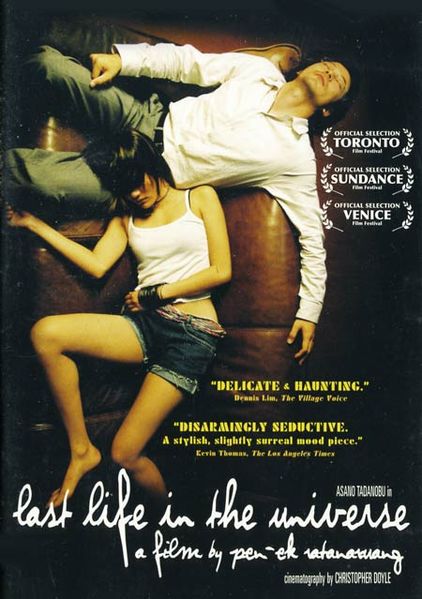Mis-Remembering THE LAST LIFE IN THE UNIVERSE
Cinema featured Pen-Ek Ratanaruang Thailand Cinema ZedThe lizard wakes up and finds he’s the last lizard alive. His family and friends are all gone. Those he didn’t like, those who picked on him in school, are also gone. The lizard is all alone. He misses his family and friends. Even his enemies. It’s better being with your enemies than being alone. That’s what he thought. Staring at the sunset, he thinks. “What is the point in living… If I don’t have anyone to talk to?” But even that thought doesn’t mean anything… when you’re the last lizard.
TLDR: I can’t decide if Pen-Ek Ratanaruang’s The Last Life in the Universe is a cross between Memento and Taxi Driver or a slightly less hardcore _Oldboy _but with caricatured Yakuza in Thailand. But what it definitely is — a strangely sublime story about two people coming together like two clouds waltzing in the sky before the rain.
My friends tend to know the sort of film I go for: slow, contemplative, vaguely themed, with high potential to emotionally wreck the viewer at a really deep level. That list is non-exhaustive, and do not do justice to the films that I really do like, but let’s leave it at that for now.
I want to talk about The Last Life in the Universe because it is one of those films that grow on you, at first because of its arguably stock post-modern open-endedness (which is not necessarily a bad thing), and later because it’s at its heart a film that is truly about the recursive nature of memory.
When I say “recursive”, I don’t really mean “circular”, but at the same time I mean that memory really does circle around itself: that we replay moments in our head, we dream dreams that borrow from our lives (and vice-versa), and Kenji seems to “remember” (“This could be me three hours from now, or maybe not.” There is an implication that this would happen somehow, or not happen somehow. Not indecision, or a not knowing, but rather this is Pen-Ek invoking Schrödinger right there and then in the closed box of Kenji’s apartment) dying and not dying at the same time.
Rather, Last Life’s plot spirals outwards, circling itself until it finds that it has run out (of ink, of film, of story, of itself). We begin with Kenji attempting suicide, attempts that continues to take shape in increasingly untenable and somewhat laughable attempts. He contemplates the noose, the gun (that kills his brother’s muderer), the bridge, the knife, lying under the front of Noi’s (protagonist B and in-story love interest) car waiting for her to drive off hoping she wouldn’t notice. One might argue that his journey back to the apartment unit that he left halfway through the film, and his escape through that window is a closing of that circle somewhat. We see the Yakuza hunting him burst through two toilet doors (a scene that recalls Tarantino’s interrupted-by-toilet-sitters trope in Pulp Fiction) only to find a vacated seat and an open window. The drop from there seems pretty steep, and we are never sure if he actually escaped, perished escaping, or is waiting in ambush à la Jason Bourne. So when I say it is a closing of that circle somewhat, I mean that we’ve ended up where we started in the story, but are in a totally different place altogether: the rope unfurls around Kenji and by the end of it we’re left with a gloriously frayed end. (And that moment when Kenji trips over what was left of the noose after waking up on his couch, a little jab by Pen-Ek telling you to pay attention — was that not telling enough?)
The thing about ropes and threads that unfurl is that in real life they don’t do it neatly. The way is knotted and tangled. Your fingers follow the thread to find where it goes only to find that where it tangles with the rest of itself has no distinction of fibres. Medium shot: Noi lies down on Kenji’s lap. She is her sister’s sister, her sister’s twin. The camera pans away, and comes back. She is her sister, wearing the blood-stained clothes that she died in (making us wonder, for a moment, what were we thinking? Back then, an older man possibly romancing the nubile young thing in a markedly kitsch Japanese schoolgirl getup, An Education-esque, in the library no less?). The next morning, still in her sister’s clothes, she burns their uniforms. Medium shot: Kenji is about to hang himself, and sticks a post-it to his right palm. Kenji is opening Yukio’s (his brother) “present” without his permission. The door buzzer cuts through the rustling of paper, and doesn’t stop. We see his brother enter, again and again, but we never see him leave. Even post-mortem, we never see his body, only a blood-speckled shape bundled underneath the table (presumably held together by the same rope). Memory is recursive, and with every re-cursion, with every re-visit, something changes ever so slightly such that you’re never quite sure if you’re remembering something, re-remembering something, or mis-remembering something. Close-up: Kenji thumbs through the pages of The Last Lizard, the book Nid was looking at in the library. The book disappears for the rest of the film, and only reappears at the end, where Noi has a visitor who has left what seems to be Kenji’s bag with the book peeping out of it. Throughout the film, Kenji asks if Noi has seen the book, which confuses Noi (which is not to say she hadn’t seen it) and leads us to wonder if the book was misplaced or simply not picked up in the first place. Remembered, re-remembered, mis-remembered.
By the end of the film:
-
Kenji fled through the toilet window (?);
-
Kenji is shirtless and detained, with The Last Lizard, his passport, a kitchen knife, two pistols, car keys, cigarettes (of which he smokes on tentatively. Kenji, the former Yakuza, who never smoked?), his stash of chopsticks, his book all laid out in front of him;
-
Kenji’s bag appears in Noi’s apartment in Osaka.
We never see him after he takes that bare-chested puff in what looks like a Thai detention centre. After the Yakuza realise that he could have escaped through the window, neither the camera nor Yakuza give chase — the shot instead fades to white (unusual. Perhaps a spiritual metaphor?). We are left wondering: if the film truly did circle around itself, then what Kenji meant by “This is bliss”? “Death is relaxing”, but not for the people who died along the way in Last Life. Each death in the film is a gesture towards Kenji’s own attempts at death. And each death, strangely, “readies” him for his “next” life, his next incarnation that he supposes in the prologue that his suicide would prepare him for. But what he did not anticipate was probably the running out of rope at the end, and the fraying of that end: that he found bliss by actually not looking to die, but by trying to finally live. That perhaps bliss is not the tying of knots, the untangling of rope, or the cutting of it, but by running your hands along it and finally reaching a frayed end. Perhaps bliss is mis-remembering.

